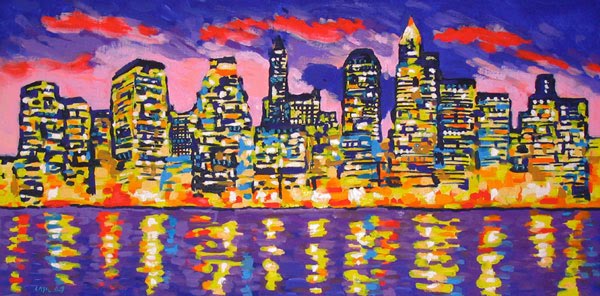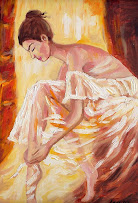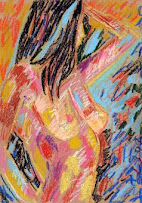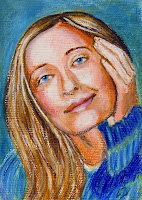ABSTRACT ART
Art that does not depict objects in the natural world, but instead uses shapes and colors in a non-representational or subjective way is Abstract Art. The term has also been used to describe Cubist and Futurist art that depicted real forms in a simplified or rather reduced way.
ART DECO
Art Deco was an early twentieth century movement in the decorative arts that also grew in influence to affect architecture, fashion and the visual arts. This style is characterized by symmetrical geometric patterns and the bold use of stepped forms and sweeping curves.
BLENDING
Blending uses an implement to move the drawing material on the paper so as to hide the original drawing strokes. This can only be done when drawing with a material such as graphite or charcoal that is not permanently attached once applied.
CANVAS
Canvas is an extremely heavy-duty fabric used as a painting surface, typically stretched. Modern canvas is usually made of cotton and comes in two basic types: plain and Duck. Artists usually use pieces of canvas as a base for their works of art. This canvas is stretched across a wooden frame called a stretcher, and is coated with gesso before it is to be used.
CARICATURE
A caricature is a portrait that exaggerates or distorts the basic essence of a person or thing to create an easily identifiable visual likeness. Caricatures can be insulting or complimentary and can serve a political purpose or be drawn solely for entertainment. The term refers only to depictions of real-life people, and not to cartoon fabrications of fictional characters.
CLASSICAL
The word "classical" refers to the period of art known as Classicism, which has a high regard for classical antiquity. This style predominated in the 18th and early 19th centuries between the Baroque and Romantic periods.
COMPOSITION
Composition is an important element in producing an interesting work of art. The artist plans the placement of elements in the art in order to communicate ideas and feelings with the viewer. The composition can determine the focus of the art, and result in a harmonious whole that is aesthetically appealing and stimulating.
CONTEMPORARY ART
The term contemporary art refers to art being done now. It tends to include art made from the late 1960s to the present. Many contemporary artists' work does not exhibit some of the key elements of the postmodern.
DIPTYCH
A diptych is a work of art (usually a panel painting) which is divided into two sections.
DRAWING
Drawing is a means of making an image, using a wide variety of tools and techniques. The main techniques used in drawing are: line drawing, hatching, cross-hatching, random-hatching, scribbling, stippling and blending. Most drawings are representational, depicting objects or scenes which the artist views, remembers, or imagines.
EXPRESSIONISM
Expressionism is the tendency of an artist to distort reality for an emotional effect, often implying emotional angst. It refers to art that is expressive of intense emotion. The basic characteristics of expressionism are bold colors, distorted forms, painted in a careless manner, two-dimensional, without perspective, and based on feelings (the child) rather than rational thought (the adult).
FIGURATIVE ART
Figurative art describes artwork which is clearly derived from real object sources, and are therefore representational. It often means art which represents a human or animal figure, but not necessarily so. The term figurative has also been used to refer to any form of modern art that retains strong references to the real world.
GEOMETRIC ABSTRACT ART
Geometric abstract art is a form of abstract art based on the use of simple geometric forms placed in non-illusionistic space and combined into non-objective compositions. Some say that geometrical abstraction is the essence of abstract art itself.
ILLUSTRATION
An Illustration is a visualisation such as drawing, painting, photograph or other work of art that stresses subject more than form. Illustrations can be used to display a wide range of subject matter and serve a variety of functions.
LINEAR PERSPECTIVE
Linear perspective is a method of portraying objects on a flat surface so that the dimensions shrink with distance. The parallel, straight edges of any object will follow lines that eventually converge at infinity. When multiple structures are aligned with each other, the horizontal tops and bottoms of the structures will all typically converge at a vanishing point.
MEDIUM
This is the means by which ink, pigment, or colour are delivered onto the drawing surface. Most drawing media are either dry (e.g. graphite, charcoal, pastel, conté, sjilverpoint) or water-based (marker, pen and ink). Watercolor pencils can be used dry like ordinary pencil, then moistened with a wet brush to get various painterly effects.
MINIMALISM
Minimalism describes movements in various forms of art and design, especially visual art, where the work is stripped down to its most fundamental features. A minimalist painting will typically use a limited number of colours, and have a simple geometric design, while minimalist sculpture is greatly focused on the materials used.
PAPER
Paper comes in a variety of different sizes and qualities, ranging from newspaper grade for practice up to expensive high quality paper. Papers can vary in texture, hue, acidity, and strength when wet. Smooth paper is good for rendering fine detail, but a more "toothy" paper will hold the drawing material better. A coarser material is useful for producing deeper contrast.
POLYPTYCH
A polyptych is a panel painting which is divided into four or more sections, or panels. Polyptychs were most common with Renaissance painters, the majority of polyptychs were designed to be altarpieces in churches or cathedrals.
POP ART
Pop art was a visual artistic movement that emerged in the late 1950s in England and the United States. It was characterized by themes and techniques drawn from mass culture such as advertising and comic books, and is widely interpreted as either a reaction to abstract expressionism or an expansion upon them.
PORTRAIT
A portrait is a painting, photograph or other artistic representation of a person. They are often simple head shots and the intent is to show the basic appearance of the person, and occasionally some artistic insight into his or her personality.
REALISM
Realism in art is the depiction of subjects as they appear, without embellishment or interpretation. Realist painters render everyday characters, situations, dilemmas, and events, all in a "true-to-life" manner. Realists tend to discard theatrical drama, lofty subjects and classical forms of art in favor of commonplace themes.
RENAISSANCE
The Renaissance is a historical age that was preceded by the Middle Ages and followed by the Reformation. The starting place of the Renaissance was Central Italy, especially the city of Florence. The Italian Renaissance did not only focus on religious figures but they also produced portraits of well-known figures of the day, and they put religious figures in Greek or Roman backgrounds.
SHADING
Shading is the technique of varying the tonal values on the paper to represent the shade of the material as well as the placement of the shadows. Careful attention to reflected light, shadows, and highlights can result in a very realistic rendition of the image.
SKETCH
A sketch is a drawing or other composition that is not intended as a finished work. The lines in a sketch are typically drawn to follow the contour curves of the surface, thus producing a depth effect. When drawing hair, the lines of the sketch follow the direction of the hair growth.
STILL LIFE
A still life is a work of art depicting a collection of usually inanimate objects, typically natural (flowers sea shells etc) or man-made domestic items (drinking glasses and food etc). Still life paintings give the artist more leeway in the arrangement of design elements within a composition than do paintings of other types of subjects such as landscape or portraiture.
STUDY
A study is a draft drawing that is made in preparation for a planned final image. Studies can be used to determine the appearance of specific parts of the completed image, or for experimenting with the best approach for accomplishing the end goal.
SURREALISM
Surrealism is an artistic and cultural movement oriented toward the liberation of the mind by emphasizing the imaginative faculties of the "unconscious mind". Surrealism in art utilizes numerous techniques to provide inspiration and free imagination by producing a creative process free of conscious control. The importance of the unconscious as a source of inspiration is central to the nature of surrealism.
TRIPTYCH
A triptych is a panel painting which is divided into three sections, or three carved panels which are hinged together.
TROMPE L’OEIL
Trompe-l'œil is an art technique involving extremely realistic imagery in order to create the optical illusion that the depicted objects really exist. Painters often add trompe-l'œil features to their paintings, playfully exploring the boundary between image and reality
by
London Art













